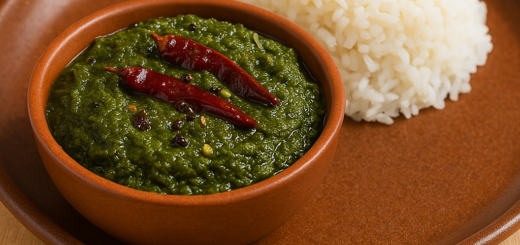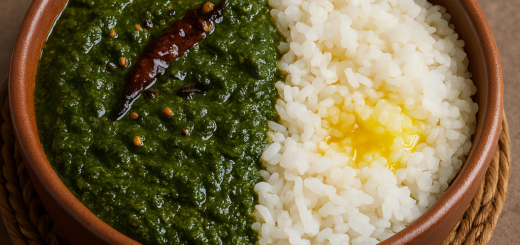Gongura Pachadi Nilava Pachadi: A Traditional Andhra Telugu Brahmin Style Recipe
Discover the delicious recipe for Gongura Pachadi Nilava Pachadi, a tangy chutney from Andhra Telugu Brahmin cuisine. Perfect with rice, ghee, or dosa!
Gongura Pachadi Nilava Pachadi: A Traditional Andhra Telugu Brahmin Style Recipe
Gongura Pachadi Nilava Pachadi is a unique variation of the famous Gongura Pachadi from Andhra Pradesh. Known for its distinct sour and tangy flavor, Gongura Pachadi Nilava Pachadi incorporates the richness of Gongura (sorrel) leaves with a flavorful twist. It is widely loved in Telugu Brahmin households for its ability to complement rice, ghee, or even dosas and idlis. This chutney captures the true essence of Andhra cuisine, balancing spice, sourness, and richness in every bite.
The Origin and History of Gongura Pachadi Nilava Pachadi
Gongura Pachadi Nilava Pachadi has deep roots in Andhra cuisine. The sourness of Gongura lends a unique flavor to Gongura Pachadi Nilava Pachadi, enhancing the chutney’s tanginess. “Nilava” refers to a specific method of preparation or a slight variation in spices and tempering compared to the traditional Gongura Pachadi. Like all traditional Andhra chutneys, this variant is packed with flavors, making it an irreplaceable side dish in daily meals or during special occasions. The addition of the Nilava (specific tempering) gives the chutney an extra kick of flavor and authenticity.
Cultural and Culinary Importance of Gongura Pachadi Nilava Pachadi
Gongura Pachadi Nilava Pachadi has deep cultural roots in Andhra cuisine. It is a dish that has been passed down for generations, often made during family gatherings, festivals, and special occasions. For Telugu Brahmin families, preparing this chutney is not just about creating a dish but honoring a culinary tradition. Gongura Pachadi Nilava Pachadi is a perfect example of Andhra’s cuisine that celebrates a variety of textures, from the smoothness of the Gongura leaves to the crunchy tempering spices. It’s more than just a chutney; it’s an essential flavor enhancer for rice, dosas, or idlis.
Ingredients Needed for Gongura Pachadi Nilava Pachadi
| Ingredient | Quantity |
|---|---|
| Gongura leaves (fresh) | 1 bunch |
| Green chilies | 3-4 |
| Garlic cloves | 4-5 |
| Red chilies | 2-3 |
| Tamarind (small ball) | 1 |
| Salt | To taste |
| Fresh coconut (grated) | 1/4 cup |
| Oil (preferably sesame oil) | 1 tablespoon |
| Cumin seeds | 1 teaspoon |
| Mustard seeds | 1 teaspoon |
| Fenugreek seeds (optional) | 1/4 teaspoon |
| Hing (asafoetida) | A pinch |
Estimated Cost of the Complete Recipe in INR
The estimated cost for preparing Gongura Pachadi Nilava Pachadi is approximately Rs. 60-90, depending on local prices for fresh ingredients.
Utensils Needed
| Utensil | Quantity |
|---|---|
| Pan or Tava | 1 |
| Mixing bowl | 1 |
| Mortar and Pestle or Mixer | 1 |
| Stirring spoon | 1 |
Cooking Temperature Details
The Gongura leaves should be cooked on medium heat to ensure they soften, and the spices in the tempering should be cooked on low heat to prevent burning and maintain their flavor.
Nutritional Information
- Calories: ~50-60 kcal per serving
- Carbohydrates: ~10g
- Protein: ~2g
- Fat: ~3g
- Fiber: ~2g
- Vitamin C: High (from Gongura leaves and coconut)
- Iron: Present (from Gongura and tamarind)
Cooking and Preparation Time
| Activity | Time |
|---|---|
| Preparation time | 10 mins |
| Cooking time | 15-20 mins |
| Total time | 25-30 mins |
Step-by-Step Cooking Procedure
- Wash the Gongura leaves: Start by washing the Gongura leaves thoroughly to remove any dirt or impurities. Separate the tender leaves from the stems.
- Cook Gongura leaves: Heat a teaspoon of oil in a pan and add the Gongura leaves. Cook on medium heat for about 5-7 minutes, stirring occasionally, until the leaves are wilted and softened.
- Roast the spices: In a separate pan, dry roast cumin seeds, mustard seeds, and fenugreek seeds (if using) on low heat for 2-3 minutes until they release their aroma. Add the red chilies and green chilies and roast for an additional 1-2 minutes.
- Grind the chutney: Once the Gongura leaves have cooled down, transfer them to a grinder. Add the roasted spices, garlic cloves, tamarind, salt, and grated coconut. Grind everything to a coarse paste. You can add a little water for a smoother consistency.
- Prepare the tempering: In the same pan, heat the remaining oil. Add mustard seeds, cumin seeds, and a pinch of hing (asafoetida). Let the spices splutter, releasing their aroma.
- Combine and cook: Add the ground Gongura Pachadi Nilava Pachadi paste to the pan with the tempering and stir well. Cook for an additional 2-3 minutes on low heat to let the flavors meld.
- Serve: Your Gongura Pachadi Nilava Pachadi is ready to serve! Pair it with hot rice and ghee, or enjoy it with dosas, idlis, or chapatis.
Tips for Cooking and Enhancing Flavors
- Use fresh Gongura leaves: Fresh leaves provide the best flavor. If you use dried leaves, soak them in water for a few hours before cooking.
- Adjust spice levels: Feel free to adjust the number of green chilies and red chilies to match your preferred spice tolerance.
- Tamarind balance: Ensure the tamarind is not overly sour, as it can overpower the chutney.
- Consistency: If you prefer a smoother chutney, add a little water while grinding.
Serving Procedure and Decoration Ideas
Serve Gongura Pachadi Nilava Pachadi with hot rice and ghee for an authentic Andhra experience. It also pairs wonderfully with crispy dosas, soft idlis, or chapatis. Garnish with fresh coriander leaves or curry leaves to enhance both the flavor and visual appeal of the chutney.
Best Food Combinations
- Best Combinations: Hot rice with ghee, chapati, dosa, idli, or curd rice.
- Foods to Avoid: Avoid pairing this chutney with rich, creamy dishes, as it might overpower their delicate flavors.
Eating Process Explanation for Best Experience
For the best experience, mix Gongura Pachadi Nilava Pachadi with hot rice and ghee. The tangy and spicy chutney, combined with the richness of ghee, creates a delicious and satisfying meal. It’s also excellent as a side dish for dosa or idli, adding a burst of flavor to your meal.
Health Tips, Benefits, and Warnings
- Benefits: Gongura leaves are a great source of vitamins A and C, antioxidants, and iron. They help in digestion, support immune function, and have a cooling effect on the body. Coconut adds healthy fats, making this chutney a perfect combination of flavor and nutrition.
- Warning: People with a sensitive stomach or acid reflux should consume Gongura Pachadi Nilava Pachadi in moderation due to its sourness.
Storage Instructions for Leftovers
Store leftover Gongura Pachadi Nilava Pachadi in an airtight container in the refrigerator for up to 3 days. You can also freeze it for up to a month. Reheat gently before serving.
Things to Know
- Seasonal Ingredients: Gongura leaves are seasonal, so it’s best to make Gongura Pachadi Nilava Pachadi during the months when fresh Gongura is available.
- Variation: Feel free to experiment with adding roasted peanuts or sesame seeds for a variation in flavor.
- Health Benefits: Gongura leaves are great for cooling the body during the summer months, making this chutney ideal for hot weather.
FAQ Section
- Can I use dried Gongura leaves for this recipe?
- It’s recommended to use fresh Gongura leaves for the best flavor. If you only have dried leaves, soak them in warm water for a few hours before using them.
- How can I make the chutney milder?
- Reduce the number of chilies or add a little jaggery to balance the sourness of the Gongura.
- Can I freeze Gongura Pachadi Nilava Pachadi?
- Yes, you can freeze it for up to a month. Just store it in an airtight container and reheat when needed.
By following this traditional Andhra Telugu Brahmin recipe for Gongura Pachadi Nilava Pachadi, you can enjoy the rich and tangy flavors of Gongura with a creamy twist of coconut. This chutney is the perfect addition to rice, ghee, dosa, idli, or chapati, and is sure to elevate your meals with its unique and authentic taste.
Learn more about the health benefits of Gongura leaves and their use in traditional Andhra dishes
Check out these related articles on traditional Andhra cuisine:


